
The first thing I did when I heard about Marvel Ultimate Alliance was to go to the video game’s official Web site. I wanted to see if the superheroes I’d loved in my childhood had made the game’s cut. Specifically, I was looking for Vision from the Avengers. And there he was on the roster. A bigger surprise was discovering a profile for Black Bolt, the ruler of Inhumans. Wow, I thought, if they’re dipping that deep into Marvel’s catalog of characters, this could be some game!
Much to my disappointment, it turned out these two faves were present only as non-player characters (along with scores of other Marvel standbys who help the storyline along at critical points). But my disappointment was short-lived, as there is no shortage of cool heroes in this massive, action-oriented battle royal. It’s a comic-book contest that promises to fulfill the digital dreams of any fan who’s ever yearned to shoot Spider-Man’s webs or put Wolverine’s adamantium claws to the test.
More specifically, Marvel Ultimate Alliance invites players to create a team of four from a roster of 20-plus playable heroes. Their task: thwarting the nefarious plot of Victor Von Doom, aka Dr. Doom. The good, er, bad Doctor has assembled a potent posse of villains, dubbed the Masters of Evil, bent on—what else—dominating the entire universe. With heavy hitters such as Ultron, Mephisto, Loki and Mandarin on his side, Doom will stop at nothing short of ruling … everything.
Battlin’ the Baddies
The story launches with a desperate plea for help from Nick Fury, leader of S.H.I.E.L.D. (a counterterrorism and espionage organization that combats supervillians). His airborne helicarrier is under attack by Dr. Doom’s forces, and he needs backup—fast.
Battle begins with a preordained compliment of four Marvel heavyweights: Spider-Man, Captain America, Wolverine and Thor. They face immediate opposition from Dr. Doom’s robotic minions, soulless legions bent on mortally impeding our heroes’ progress. These robots offer easy target practice as you get the hang of your characters’ powers. In addition to basic melee attacks and moves such as jumping and flying, each character has unique powers. (Spider-Man fires web projectiles, for instance.) Progress through the levels yields credits to further upgrade heroes’ superpowers and basic fighting skills.
Doom’s robots soon give way to flesh-and-blood baddies, second-tier opponents such as Bullseye, Blackheart and Grey Gargoyle. Fighting action is fierce, but the gameplay is as bloodless and free of gore as most comic books were when I first started reading them in the 1970s. Vanquished villains simply fall over dead, and their bodies disappear in a few seconds. Occasionally, a well-placed shot will decapitate a robot, but human victims are rarely dispatched so brutally.
It’s not long before you reach a checkpoint that enables you to swap out different heroes for the original four. I was particularly keen on trying out those who can both fly and have ranged energy beams or long-distance attacks, such as Iron Man and the Human Torch. Once in command of the latter, I discovered that his fiery attacks momentarily surround victims with flames—which is about as graphic as the game’s battle imagery ever gets.
Other content issues include one mild profanity in the game’s opening cinematic sequence (Nick Fury exclaims, “What the h—“) and comic-book sensuality that emphasizes female characters’ overly endowed bodies.
Fiery Abodes, Spiritual Worldviews
Arguably more problematic are the realms that the game’s storyline explores. Not only do our heroes fight battles on earth and in outer space, but they travel to mythic worlds such as Asgard (home of the Norse god Thor and his nemesis, Loki) and Mephisto’s fiery, hellish abode (complete with undead warriors and a demon-like being made of fire and crowned with horns). Players also encounter occult artifacts in the home of the sorcerer Dr. Strange. It’s no stretch to say that this game spans the wide variety of worlds and worldviews found in the Marvel Universe, a place where magic, mythological gods, aliens, the undead, superheroes, villains, demons and sorcerers all vie for power and control.
Given such content, the same kinds of questions we’ve posed about magic and the occult in the Harry Potter stories are relevant here as well. From start to finish, Scripture consistently warns against trying to communicate with the dead and the spirit realm, condemning these practices as inappropriate behavior for God’s people (Leviticus 20:27, Deuteronomy 18:9-14, Revelation 21:8).
Most players, of course, will likely blast through the game’s superpowered antagonists without giving much thought to the mythical, magical worlds in which they sometimes find themselves. I certainly didn’t think about these sorts of spiritual issues when I first got into Vision and Black Bolt. But maybe I should have. Maybe we all should. As far as Marvel Ultimate Alliance is concerned, these are the kinds of questions that deserve our scrutiny—even more so (but without minimizing) the game’s relatively mild T-rated violence, language and sensuality.

After serving as an associate editor at NavPress’ Discipleship Journal and consulting editor for Current Thoughts and Trends, Adam now oversees the editing and publishing of Plugged In’s reviews as the site’s director. He and his wife, Jennifer, have three children. In their free time, the Holzes enjoy playing games, a variety of musical instruments, swimming and … watching movies.